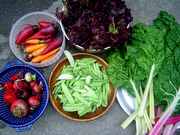

|
| Vegetable Varieties for Gardeners is a citizen science program
|
|
|
|
'Blue Speckled Tepary' Beans |
| |
| Sub-Category: |
Bush
Other
|
| |
|
| Sub-Category 2: |
| | Description: |
Bush tepary bean. 2- to 3-foot plants bear plump, medium-sized, brown seeds. Drought tolerant and adaptable to intense heat and dry conditions.
|
| Days To Maturity: |
85-90
|
| Seed Sources: |
|
| |
| Rating Summary |
| |
Overall: (3.0 Stars)
Taste: (1.3 Stars)
Yield: (1.7 Stars)
Ease/Reliability: (2.7 Stars) |
| |
| Reviews |
| |
Login to share your Review of Blue Speckled Tepary.
Number of Reviews: 3
KEY: O=Overall Rating, T=Taste, Y=Yield, E=Ease
Reviewed on 05/28/2018 by
farmerdill
- An experienced gardener
|
 Overall Overall
 Taste Taste
 Yield Yield
 Ease Ease
|
Richmond, Georgia, United States
Frost Free Season: 183 - 203 days
Soil Texture: Sand
Garden Size: Large - More than 1,600 square feet (40' x 40')
Sun Exposure: More than 8 hours per day
|
| A very small bean suitable only as a dry bean. Grows ok here, small bush plant, loads up with tiny pods. Not worth the space for my uses. |
| |
|
Reviewed on 04/20/2010 by
steev
- An intermediate gardener
|
 Overall Overall
Taste
Yield
 Ease Ease
|
Colusa, California, United States
Frost Free Season: 163 - 183 days
Soil Texture: Not Sure
Garden Size: Large - More than 1,600 square feet (40' x 40')
Sun Exposure: More than 8 hours per day
|
| I find this much better suited to the extreme heat where I grow than other beans. |
| |
|
Reviewed on 03/01/2010 by
sea-kangaroo
- An experienced gardener
|
 Overall Overall
Taste
 Yield Yield
 Ease Ease
|
Santa Clara, California, United States
Frost Free Season: More than 203 days
Soil Texture: Not Sure
Garden Size: Medium - 400 square feet to 1,600 square feet
Sun Exposure: 6 to 8 hours per day
|
| Tried this for a couple of years, planting it at different times of the year, but the plants just never produce much of anything. |
| |
|
|
|
|
Vegetable Varieties for Gardeners is a citizen science program, © 2004-2024, All Rights Reserved
Cornell Garden Based Learning, Cornell University College of Agriculture & Life Sciences, Horticulture Section
|






 VVfG home
VVfG home
 Taste
Taste Ease
Ease

